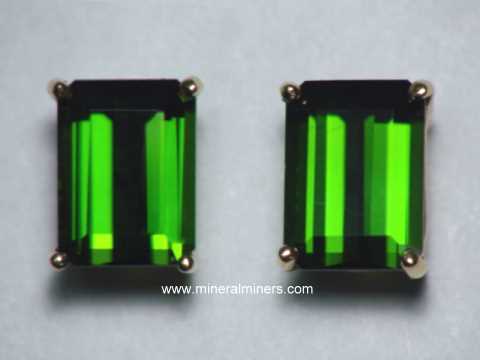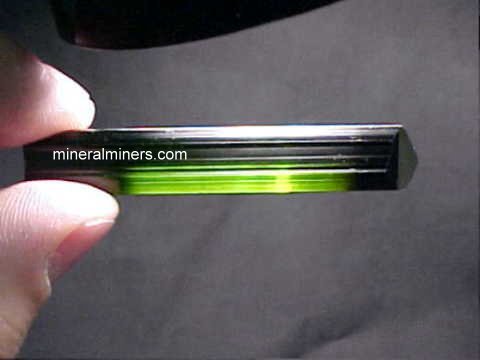Go up to the Tourmaline Information Index
General composition: (Na, Ca)(Li, Mg, Al)(Al, Fe, Mn)6 (BO3 )3 (Si6 O18 )(OH)4
Chemical Composition of Ideal Endmember Tourmaline Species
Buergerite Tourmaline : NaFe3 Al6 B3 Si6 O30 F
Chromdravite Tourmaline : NaMg3 [Cr,Fe+3 ]6 B3 Si6 O27 (OH)3 (OH,F)
Dravite Tourmaline Magnesian Tourmaline ): NaMg3 Al6 B3 Si6 O27 (OH)3 (OH,F)
Elbaite Tourmaline Lithian Tourmaline ): Na(Li,Al)3 Al6 B3 Si6 O27 (OH)3 (OH,F)
Feruvite Tourmaline : CaFe+2 3 Al6 B3 Si6 O27 (OH)3 (OH,F)
Foitite Tourmaline : [Fe+2 2 (Al,Fe+3 )]Al6 B3 Si6 O27 (OH)3 (OH,F)
Liddicoatite Tourmaline 3 Al6 B3 Si6 O27 (OH)3 (OH,F)
Olenite Tourmaline : NaAl3 Al6 B3 Si6 O27 (OH)3 (OH,F)
Povondraite Tourmaline : NaFe+3 3 Fe+3 6 B3 Si6 O27 (OH)3 (OH,F)
Schorl Tourmaline : Na(Fe,Mn)3 Al6 B3 Si6 O27 (OH)3 (OH,F)
Uvite Tourmaline 3 (Al5 Mg)B3 Si6 O27 (OH)3 (OH,F)
Class: cyclosilicates
Crystal system: hexagonal-rhombohedral; 3m
Crystal habit: commonly forms prismatic crystals with well developed
trigonal prism and second-order hexagonal prism faces, can be elongated or
flattened, commonly vertically striated. In cross section the prism faces
often round into one another giving the appearance of a spherical triangle.
Doubly terminated tourmaline crystals often show different forms at each end of the
vertical axis. Also radiating, acicular, columnar, massive.
Twinning: very rare and simple on pyramidal planes such as {1011}
Specific gravity: 2.96 - 3.31 (buergerite 3.31, dravite 3.03-3.15, elbaite 3.03-3.10, liddicoatite 3.02-3.08, schorl 3.10-3.25 and uvite 2.96-3.06)
Index of refraction: 1.610-1.735 (buergerite 1.655-1.735, dravite 1.610-1.661, elbaite 1.615-1.655, liddicoatite 1.621-1.637, schorl 1.625-1.675 and uvite 1.612-1.638)
Birefringence: 0.016-0.080 (buergerite 0.080, dravite 0.021-0.026, elbaite 0.016-0.024, liddicoatite 0.016,schorl 0.025-0.035 and uvite 0.017-0.020)
Pleochroism: strong in all species
Hardness: 7.0 - 7.5
Color: tourmalines occur in all colors. Buergerite is dark brown to black.
Dravite is usually
brown to black, can be colorless. Elbaite
and liddicoatite occur in a wide range of colors and shades including brown tourmaline, green tourmaline
(see our selection of natural color green tourmaline earrings with many different shades of light to dark green), blue tourmaline (see also our natural color blue tourmaline gemstones , yellow tourmaline, pink tourmaline (see our selection of natural color pink tourmaline earrings ) as well as red tourmaline and even colorless tourmaline. Black tourmaline is usually the variety Schorl Uvite is usually black,
brown or green. Tourmaline crystals
are often color zoned concentrically and/or along the C axis.
Luster: vitreous to resinous, can occur with chatoyancy due to tubular cavities parallel to the C axis.
Transparency: transparent to opaque
Cleavage: poor in all species except buergerite which has distinct prismatic cleavage
Fracture: conchoidal, brittle
Streak: white
Go up to the Tourmaline Information Index
Tourmaline is the name given to a group of related minerals all having
essentially the same crystal structure but varying considerably in chemical
composition and in some of their physical properties. It is best described
as a very complex aluminum borosilicate. There are eleven distinct
mineral species of tourmaline based on chemical composition: buergerite ,
chromdravite , dravite , elbaite , feruvite ,
foitite , liddicoatite , olenite , povondraite ,
schorl and uvite
Tourmaline occurs in all colors. Commonly used names have been given to
tourmalines of specific colors or
color combinations such as rubellite tourmaline (see our natural color rubellite tourmaline jewelry indicolite blue tourmaline jewelry ), sunset tourmaline watermelon tourmaline elbaite
and liddicoatite can look exactly the same and laboratory analysis
is necessary to determine the precise tourmaline species, the generally
preferred nomenclature today for tourmalines that have not been lab analysed
is simply to use the color
of the specimen as a prefix followed by tourmaline as in green tourmaline crystalsblack tourmaline crystals
The color in tourmaline is due to the presence of metal ions (Fe, Mn, Cr, V, Ti and Cu)
in its crystal structure.
The color we see in tourmalines is produced when light is absorbed
by these ions or by interactions between these ions (intervalent charge
transfers).
Some tourmalines form with inclusions of thread-like tubes or cavities
which usually occur parallel to the length of the crystal. If these inclusions
occur in sufficient number, they may produce a chatoyant effect that yields a
cat's-eye when cut into a cabochon gem.
Go up to the Tourmaline Information Index
black tourmaline and is associated with
microcline , albite , quartz and muscovite . The light colored gem tourmalines are
much more rare, usually occuring in pegmatite core zones with quartz (often as smoky quartz ), cleavelandite ,
muscovite , lepidolite , morganite , and more rarely with amblygonite and spodumene (variety: kunzite ).
Other occurances for tourmaline are: with quartz in hydrothermal veins where heated
mineral bearing liquids or gases from deep igneous sources later cooled and
crystallized along rock fractures, and in granites due
to late stage alteration of micas and feldspars by boron containing fluids. Large black tourmaline crystals also form by boron metasomatism
in contact and regionally metamorphosed rocks. Some tourmaline bearing mica
schists may have formed by regional metamorphism of argillaceous sediments containing
evaporite borates.
Because of it's relatively high specific gravity and hardness, tourmaline is
occasionally found in eluvial and aluvial deposits.
Tourmaline is usually recognized by its rounded triangular basal sections,
color, lack of cleavage and conchoidal fracture. Transparent specimens can often be
distinguished by their strong pleochrism/dichroism.
Go up to the Tourmaline Information Index
turmali which was originally
applied to an assortment of colored stones being mainly zircons.
Buergerite was named after Professor Martin J. Buerger, a well
known research scientist and crystallographer.
Dravite was named
after the Drave region in Carinthia. Elbaite was named after the isle of Elba
in Italy, and liddicoatite was named after Richard T. Liddicoat of
the the Gemologial Institute of America. Schorl is an old German mining
term for gangue minerals. Uvite tourmaline
Tourmaline gemstones are widely used, occuring in all colors. Tourmaline also
has many scientific and technological uses due to the fact that an electrical
charge can be induced in some tourmaline crystals simply by applying
pressure to the crystal in the direction of the vertical crystal axis.
This effect is known as piezoelectricity , and has many uses in
pressure measuring equipment and other scientific applications. Some tourmalines also show pyroelectricity ,
which occurs when the crystal is heated yielding a positive charge at one
end of the crystal and a negative charge at the other.
Tourmaline is the birthstone for the month of October.
See Our Natural Tourmaline Necklaces
Go up to the Tourmaline Information Index
Metaphysical properties for the specific colors of tourmaline are
given below:
Black Tourmaline Crystals :Black Tourmalines are also said to sharpen
one's wits, to enhance vitality and to give emotional stability.
Blue Tourmaline :Green Tourmaline pink tourmaline jewelry pink tourmaline earrings or jewelry is also said to give wisdom and enhance one's willpower.
Watermelon Tourmaline :Tourmaline Product Groups: Follow any link to view our on-line inventory of that category
for all tourmaline varieties many images!)




 The tourmalines are a group of related minerals all having essentially the same crystal structure but varying considerably in chemical composition and in some of their physical properties. They occur in all colors including black and colorless. Commonly used names have been given to tourmalines of specific colors or color combinations such as indicolite for blue tourmaline and watermelon tourmaline for tourmalines showing concentric color zoning with pink-red cores surrounded by green.
The tourmalines are a group of related minerals all having essentially the same crystal structure but varying considerably in chemical composition and in some of their physical properties. They occur in all colors including black and colorless. Commonly used names have been given to tourmalines of specific colors or color combinations such as indicolite for blue tourmaline and watermelon tourmaline for tourmalines showing concentric color zoning with pink-red cores surrounded by green.